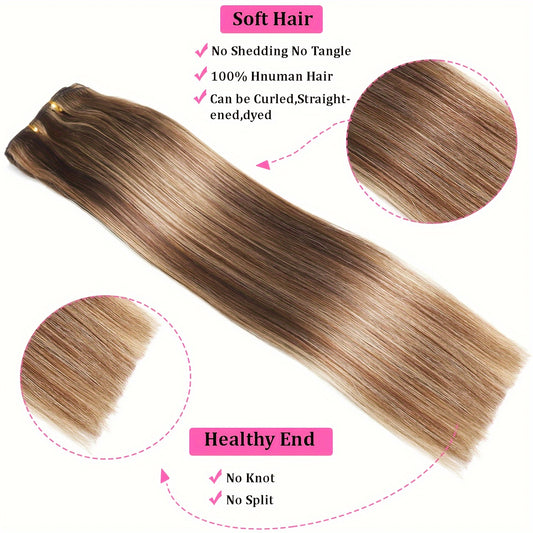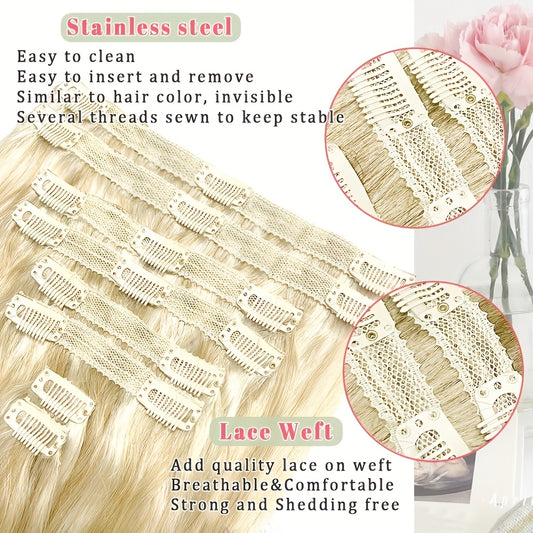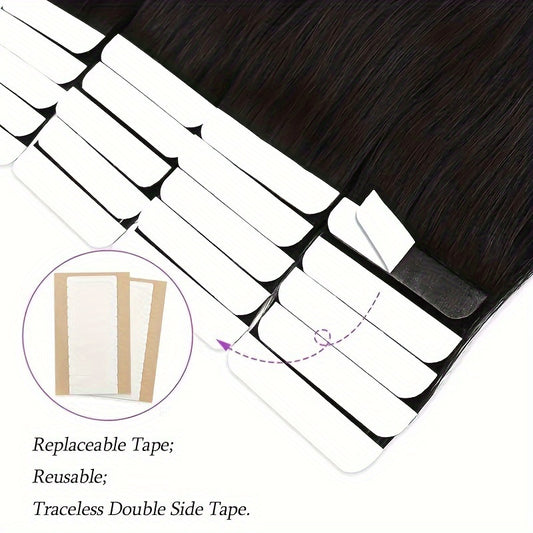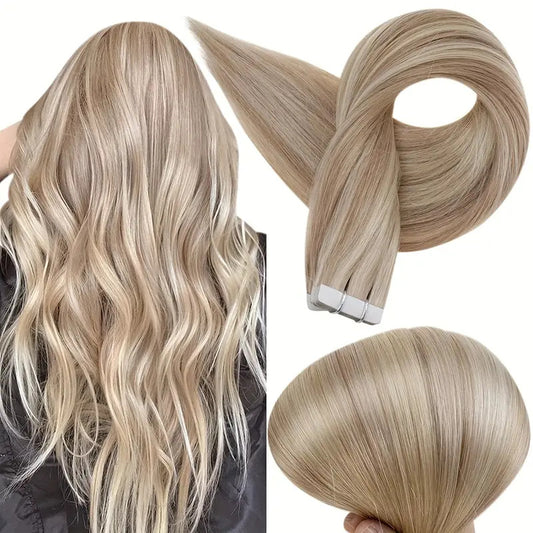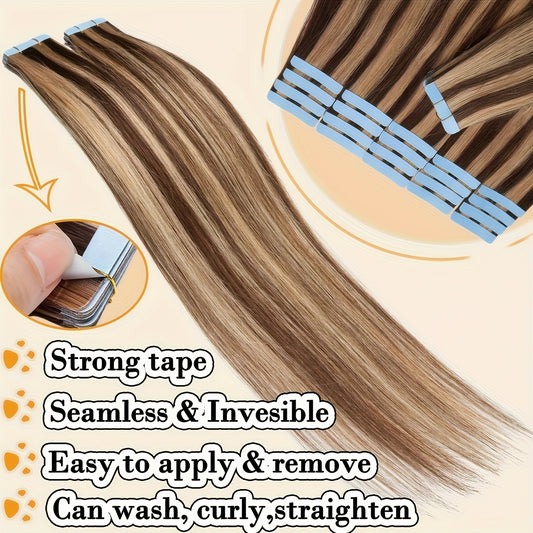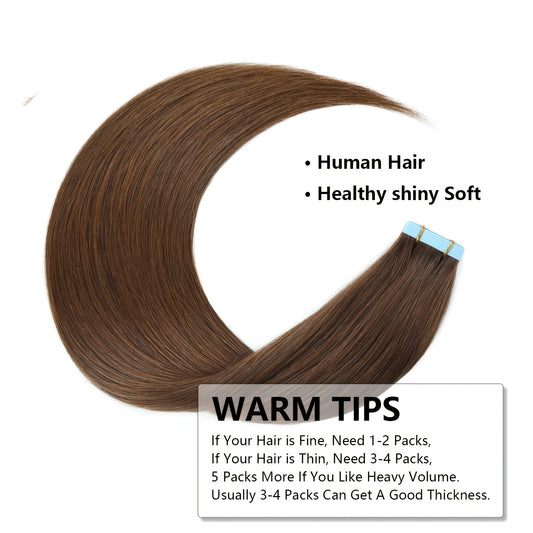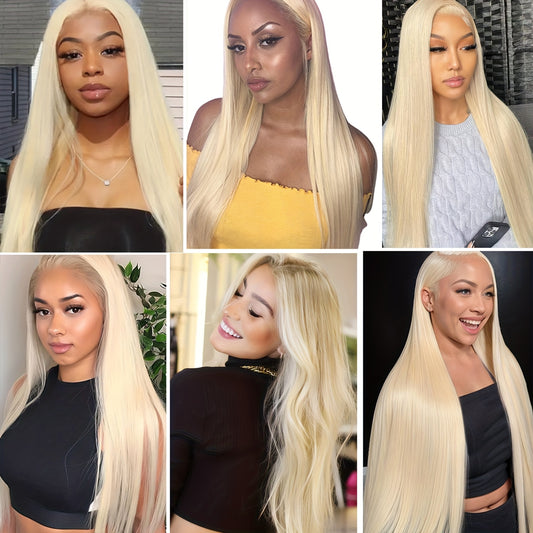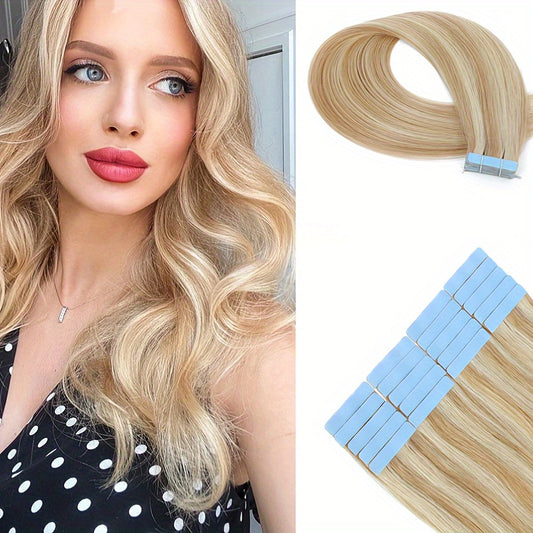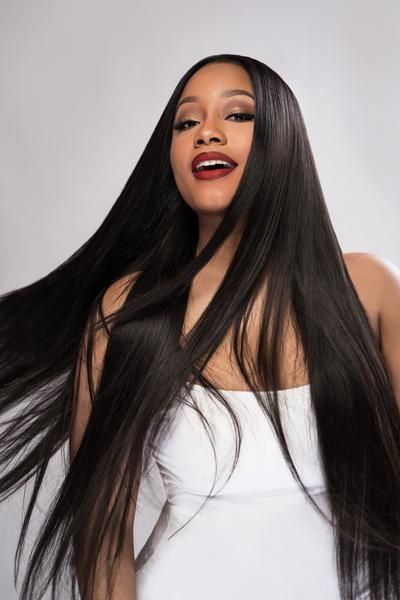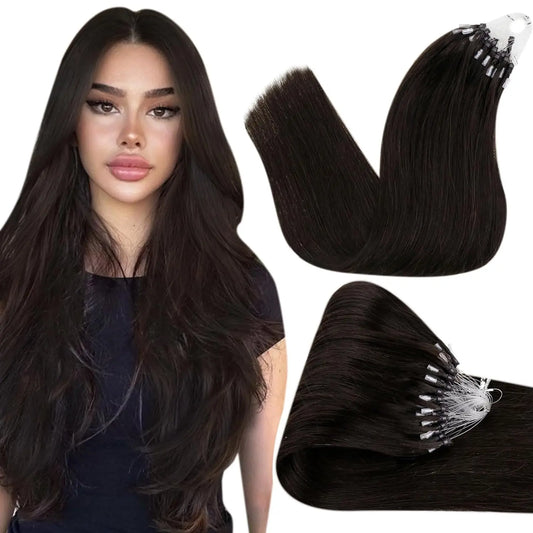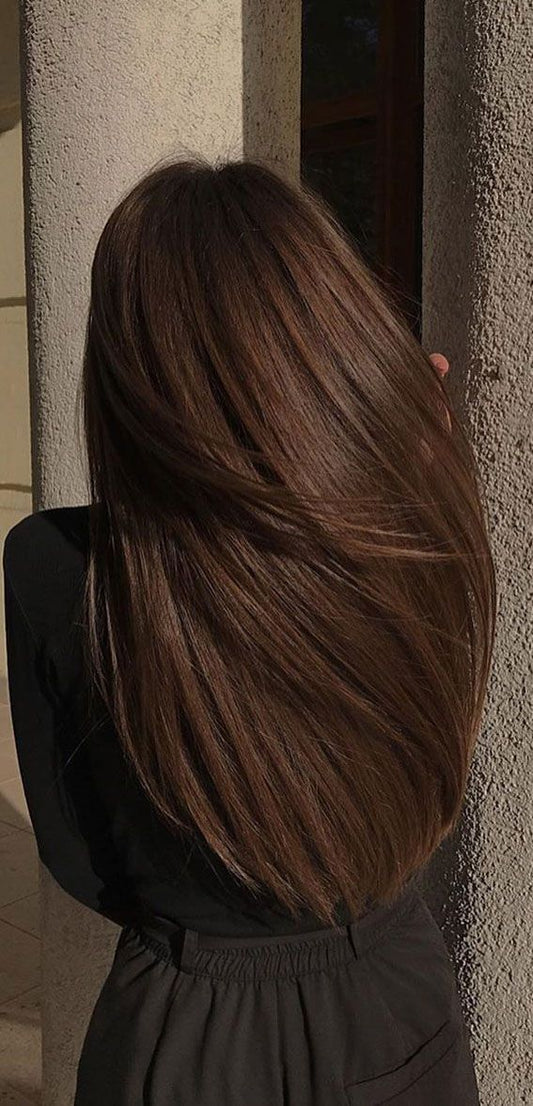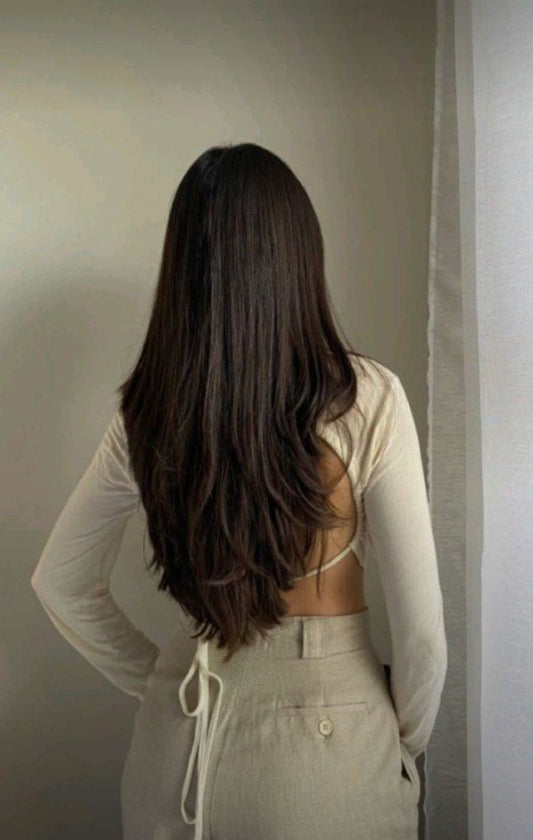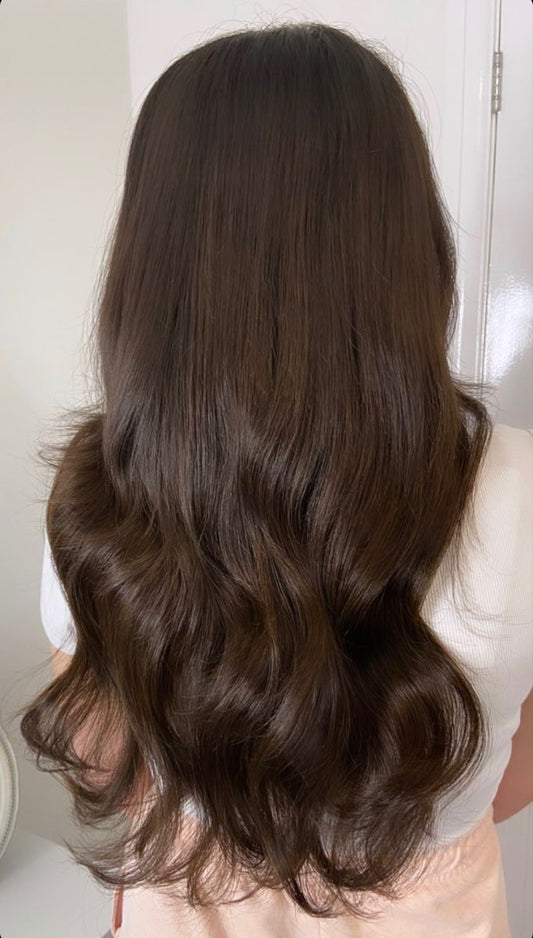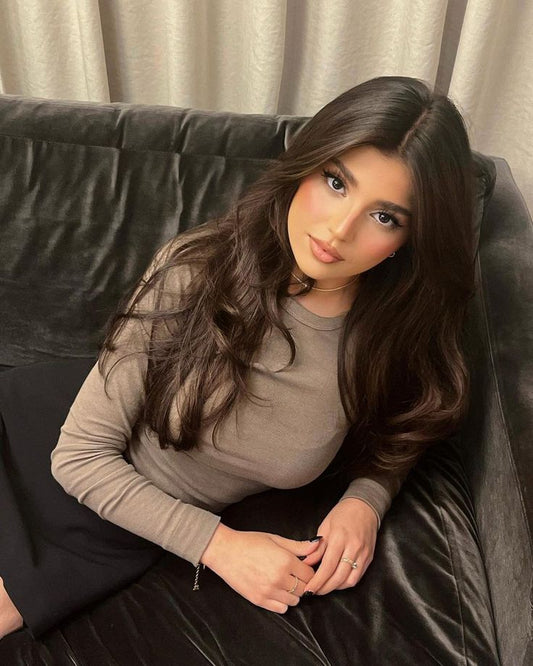About 26 Inch Hair Extensions
What twenty six inches looks like on the body
For most wearers a true 26 inch straight finish lands near the natural waist or slightly below. Petite frames may see the hem move closer to the hip; taller frames may see the hem at low ribs or upper waist depending on torso length. Soft waves reduce apparent length by about one to two inches; tight curls reduce more. Because the hair interacts with clothing and furniture frequently at this length, expect to brush once after removing outerwear and to place a tiny drop of serum on mid lengths and ends only to calm static. Keep roots free of oils so anchors hold and seams stay flat.
The camera judges the bottom third of the silhouette first. If ends look foggy, the style reads unfinished no matter how beautiful the top is. If the hem is bold and tidy, the brain reads the entire look as premium. That impression is not a product trick; it is a selection decision: grams, draw (end fullness), and simple placement that protects your top layer in motion.
Who chooses this length
Buyers who want ultra long hair that photographs as a feature choose 26 inches. Creators and presenters use it for dramatic wave sheets, long braids, and sleek lines that read cinematic. Event wearers choose it when they want a dress length silhouette and noticeable movement in video. Some everyday wearers simply prefer the proportion and enjoy the routine. All groups benefit from the same controls: correct grams, a clean install map, and a calm care plan that respects length and weight.
If your natural hair is above the cheekbone, constant concealment will be difficult until your top layer grows; consider a halo or shorter length first. If your natural hair is very dense and blunt, you will likely need higher grams and double drawn ends for straight finishes. If daily high ponytails are required, standard clip maps will flash; weft or professional methods may be the better path. These are boundary conditions, not problems—matching method to routine is the win.
Grams planning for extra long builds
Grams decide end authority. A light set looks long but unfinished; a balanced set looks long and deliberate. Use a simple ladder to avoid guessing. Around ninety to one hundred twenty grams: subtle fullness and improved ends for fine, layered natural hair worn mostly in waves. One hundred thirty to one hundred sixty grams: everyday full head that photographs dense while feeling light—common for many wearers. One hundred seventy to two hundred forty grams: plush hem for blunt cuts, thicker strands, studio lights, or humid climates where waves relax. Above two hundred forty grams: specialty builds for very dense natural hair or crisp straight looks under hard light.
Map grams to haircut and head size. Blunt shoulder or collarbone cuts usually require higher grams so the extension hair meets the line without a shelf. Layered shoulder length can use medium grams because layers hide join points. Fine, wispy mid lengths often shine with a medium set plus two very narrow temple boosters. Thick tapered natural hair can balance with one heavy back row and one medium row rather than stacking many light pieces near the crown. Choose grams for the photo you want: a graphic straight edge needs more mass than a romantic wave.
End fullness and draw choices
Single drawn hair tapers at the tips like natural growth; it brushes into motion easily and loves waves. Double drawn hair keeps density deep into the lower third and reads like a fresh cut—square, decisive, and calm in straight or beveled finishes. At 26 inches double drawn often photographs as more expensive because the hem occupies more of the frame. Neither is mandatory. If the only option is single drawn, a micro trim of half an inch to one inch turns a taper into a firm line without sacrificing the idea of ultra long length.
Do not rely on adjectives. A cropped back view of the ends at rest in daylight tells the truth about density and trumps descriptions. If a page does not show the hem, request the proof photo before you pick grams.
Texture options and effort control
Straight texture makes the longest visual drop and shows a razor edge when beveled. It also shows friction and static fastest at this scale, so brushing and heat discipline matter. Body wave is the universal blender; it smooths with one low heat pass and expands into plush curves with modest effort. Loose curl and deep wave arrive with pattern; blending is simple if the coil diameter matches your own hair. Coily patterns should be labeled by diameter and shrinkage with proof photos of defined and brushed out states so behavior is predictable.
Choose texture by daily habit, not identity. If you mostly wear blowouts, straight is fine. If you mix smooth days with bend days, body wave saves time. If you live in curls, match coil scale so the join disappears. Seamless choice limits the number of heat passes and keeps the routine light.
Color matching in daylight
Match undertone first—cool, neutral, warm—and depth second. Verify color at a window in daylight; bathroom bulbs skew yellow or blue and can trick the eye. If you sit between shades, slightly lighter is safer because Remy human hair accepts toners that cool or darken; lifting lighter raises cuticles and shortens life. Rooted and balayage options blur seams along parts and temples and help darker roots blend. Take a quick daylight photo of your match and save it; that record keeps reorders consistent across seasons and devices.
Common edge cases are calm. Cool brunettes that read warm indoors should trust daylight or apply a brief cool glaze. Warm brondes that change with environment benefit from a soft root. Deep browns with red cast should start neutral and tone cooler in small steps. For gray blending, choose a neutral gray and tune with violet or blue only if needed.
Why remy human hair matters
Remy hair keeps cuticles aligned in one direction. This lowers friction, limits matting, and produces a soft natural sheen instead of glassy glare. With aligned cuticles you can style with moderate heat and get predictable results: one slow pass to smooth, curls that hold after cooling, and wash cycles that do not roughen the surface quickly. Heavy silicone masking looks perfect on day one and then washes off unevenly; minimal processing with honest toning tolerance is the path to long wear at 26 inches.
At extra long length the hem is the story. Material integrity is why the story stays clean for months, not weeks. The result on camera and in person comes from fiber quality and small, repeatable habits more than from heavy product loads.
Attachment method overview
Clip in: fast, reversible, and learnable. A 26 inch clip in set is ideal for shoots and events and for wearers who like to remove hair before sleep. It requires generous top layer coverage and calm placement to avoid flashing in wind or fast turns. Halo: wire supported single piece that installs in seconds; concealment is easy on medium to long natural hair but requires practice on very fine hair. Weft (sew in, beaded row, braidless sew in): rows distribute weight and provide a dense, stable perimeter for long days; move ups every six to eight weeks keep comfort and coverage intact. Tape in: ultra flat tabs for distributed fullness that also play well with length when mapped low and even; oil discipline near tabs is critical.
Method follows lifestyle. Daily removers choose clip ins or halo. Multi week wearers choose wefts or tape. Sensitive scalps select the lowest tension option that still achieves the desired edge.
Clip in placement map at this length
Detangle natural hair and wefts. Section above the nape and anchor the widest weft with the center clip first, then the sides. Move upward one row by a finger to an inch, place the next widest weft where the head begins to curve, then add medium wefts along the occipital arc. Place narrow pieces at the sides to fill temples and shape the face frame. Keep the crown layer generous; it is your concealment budget. Tease very lightly where clips will sit and mist a small amount of flexible spray for grip. Keep roots clean of oils.
At 26 inches add a slim cover weft one step higher on each side for wind insurance. This piece hides under the crown layer and prevents flashes outdoors, during quick turns, or in crowded spaces where hair gets nudged. Smart coverage beats raw piece count.
Row mapping for wefts
In a 26 inch weft plan the nape row establishes anchor stability, the occipital row builds body, and a row below the crown determines how the outline survives movement. Machine or flat weft at the nape handles friction; hand tied or flat wefts higher keep bulk low. Bead spacing must be consistent and tension light enough to avoid pinching. Temple panels deserve special care—two narrow, slightly angled pieces remove hollows that appear in three quarter photos and when tucking hair behind the ear.
During move ups (typically every six to eight weeks), shift anchors by a few millimeters, inspect seams, and micro trim the edge if it has softened. Installing rows too high is the common exposure mistake at ultra long length; keep rows where the crown layer still drapes generously over them.
Blending and finishing system
Heat discipline: cap tools at or under one hundred eighty Celsius or three hundred fifty Fahrenheit. One slow pass polishes better than several quick passes. Cooling: let sections cool fully before brushing; brushing hot erases the shape you just set and invites more heat. Product rhythm: protectant before heat, flexible spray on the brush rather than directly on hair, then a pea of serum on mid lengths and ends only. Bevel the last half inch to one inch on straight days to make the hem read like a fresh cut.
Direction plan: curl the back in alternating directions for plush movement and curl the front away from the face. Brush into one pattern after full cooling. If the part line looks stark on camera, dust a small washable root powder for a soft shadow. If the bottom edge reads soft in straight photos, ask for a half inch micro trim; small trims produce big clarity at this length.
Wind and movement strategy
Wind exposes seams when the crown layer is thin or the part sits directly over a row. Keep the crown layer ample. Shift the part a few millimeters if a seam wants to show. Add the slim cover weft higher for outdoor days. For transitions, use one ear tuck while moving between buildings and release it inside. In cars, place hair over one shoulder and brush once after arrival. Under hats and hoods, map rows slightly lower and tuck front sections behind the ears before pulling the hat down, then release.
At 26 inches, choose bags with smooth straps and avoid hook-and-loop closures near ends. Zipper guards on jackets reduce snags. These unglamorous moves preserve the hem better than any serum.
Comfort and ergonomics
Weight should distribute across rows or clips, not concentrate at the crown. Support the weft with the free hand while brushing to avoid torque on seams. Rotate exact clip positions by a few millimeters between wears to protect the same follicles from repeated pressure. If your scalp feels tender, remove one piece for daily wear and add it back for events; comfort is not optional. For very fine hair, a halo can carry length for long days with minimal root stress.
Long hair changes small motions: sit down by sweeping hair forward or to the side; zip jackets slowly and let hair drop after. These habits become automatic and prevent unnecessary friction and tugging.
Care routine in short steps
Before wear: brush natural hair and wefts. Install using the map and keep roots clean. Style with moderate heat and allow complete cooling before brushing into the final pattern. During the day: brush once after removing outerwear or after long seating to reset the hem. After wear: brush, coil wefts in a gentle U, and store in a satin pouch away from heat and moisture. Do not sleep in clip ins. For weft rows, low braid for sleep and use a silk pillowcase or bonnet.
Washing cadence: clip ins every ten to fifteen wears or when product buildup appears; rows one to two times per week depending on scalp. Shampoo the scalp and let suds pass through lengths, condition mid lengths to ends, rinse cool, blot with microfiber, and air dry as far as possible before finishing with low heat. Clarify rarely. A seasonal micro trim of half an inch resets edge authority for the camera and typically looks better than chasing density with extra grams.
Troubleshooting quick list
Weft flash in wind or bright light: top layer is thin or a part sits over a seam; shift the part, add a higher cover weft, or lower the row at the next install. Ends read wispy in straight photos: request a half inch trim or select double drawn next order. Nape tangles under coats and straps: reduce heat for a week, hydrate ends, and brush after removing layers. Clip slip on fine hair: clean clip teeth, add a light root texture spray, and avoid freshly conditioned anchor zones.
Color looks right outdoors but too warm indoors: trust daylight and, if needed, apply a short cool toner. Scalp tenderness: reduce piece count, vary placement a few millimeters each wear, and add rest days. Too much shine on camera: spray flexible hold on the brush and sweep once instead of spraying directly. Small, calm changes solve most issues without heavy product.
Event and travel plan
Event day: set curls or bevel ends early, let everything cool fully while you do makeup, brush into one pattern, and sweep once with flexible hold on the brush. Pack a mini kit with a loop brush, small flexible spray, a pea size serum, two spare clips, and a satin pouch. For outdoor events, plan one ear tuck and a part shift option; these two moves prevent most exposure moments.
Travel day: store wefts brushed and coiled in satin; on arrival, hang for a few minutes to relax; refresh with a light mist and a quick brush. Cabin air is dry; apply only a tiny drop of serum to the ends so mid lengths do not collect dust. Seat backs and headrests rub long hair—sweep hair forward during long rides and reset with one brush at your destination.
Page elements that help buyers
A useful collection page names the length and method clearly, shows each shade in daylight from front, side, and back, and includes a cropped end shot at rest. One simple line states where 26 inches lands on the body and typical install time. Filters for grams, texture, construction type, and shade family help visitors find their match fast. Each product tile should list grams and texture and a small cue like everyday density, blunt cut ready, or studio hem.
A compact how to apply diagram—section, anchor, blend—builds confidence. An FAQ answers heat caps, wash cadence, return basics for unopened hair, and a daylight undertone reminder. Every sentence is a decision aid, not filler. Product and FAQ schema help searchers without cluttering the page.
Accessibility and localization basics
Pair shade names with numeric descriptors like level 6 neutral brown so color blind buyers can map options. Provide alt text that includes length, texture, undertone, and draw. Ensure filters are keyboard accessible and changes announce to screen readers. Show each color on at least two complexions and include a strand on a white card to neutralize background bias. Use inches and centimeters and keep grams consistent across regions.
Publish realistic shipping windows and customs notes. Offer at least one support channel with clear response times across time zones. Clarity here moves visitors from curiosity to purchase without friction.
Safety boundaries
Do not sleep in clip in hair extensions. Do not set heat tools above recommended limits. Do not apply heavy oils at the roots; anchors need clean texture. Do not attempt to lift color lighter on extensions; tone darker or cooler instead. Do not stack many pieces near the crown where the top layer is thin. If you have a scalp or skin condition, consult a professional before choosing a method. These boundaries are practical guardrails that protect comfort and lifespan.
If a step feels hard, slow down and reset. The basic rhythm—section, anchor, blend, cool, brush—solves nearly everything with fewer passes and less product.
Simple economics and value
A removable set or well maintained rows often produce the best cost per wear for people who alternate hair down days with hair up days. Because the hair rests between uses, fiber fatigue builds more slowly than with constant wear methods. A true Remy set treated with moderate heat, full cooling, and satin storage lasts months; divided over events and shoots, the per wear cost compares favorably with frequent single appointment services. The bigger savings is time: a five to ten minute install replaces travel and waiting for a chair.
Brands that show grams calculators, daylight end crops, and heat caps reduce returns and support tickets. Fewer returns mean less waste and more stable prices—clarity is the quiet value engine.
Glossary
Grams: total weight in the set; controls end fullness. Draw: how much thickness remains at the ends—single tapers, double stays thick. Weft: a horizontal track of hair sewn or tied together; used in sew in and beaded row installs. Clip in weft: a weft with small clips for removable wear. Cover weft: a slim piece placed higher to hide joins. Occipital: back curve of the head where mid rows sit. Perimeter: the visible outline at the ends. Rooted: slightly deeper shade at the top to blend parts.
Balayage: gradual lightness through lengths that softens seams. Cooling rule: let hot hair cool before brushing so the shape sets. Temple panel: a narrow piece placed near the temple to remove hollows and balance the face frame. Bevel: a small curve at the ends used to make straight hems read like a fresh cut.
Summary
Twenty six inch hair extensions deliver a dramatic, camera ready length that still behaves well when you plan grams, draw, texture, color, and placement with care. Choose grams for the photo you want—soft wave or graphic straight edge. Match color in daylight by undertone first and consider rooted or balayage for darker roots. Keep tools moderate, cool before brushing, and store brushed pieces in satin. Protect comfort by distributing weight and rotating exact clip positions. With these small, repeatable habits, ultra long hair looks intentional instead of fussy and stays that way through travel, work, and events.
When in doubt, return to the basics: section, anchor, blend, cool, brush. Trust the daylight check. Cap heat. Support the row while brushing. Small decisions repeated calmly produce the best results at this length.
Use cases by routine
Office days favor a beveled blowout or a sleek low pony that clears blazers and headsets. Teaching or streaming reads best with brushed wave sheets because they stay coherent on camera. Weddings and formal events like uniform curls brushed into a single pattern; they look deliberate from first look to last dance. Travel days benefit from a compact claw clip twist and a tidy ear tuck during movement, then a brush out on arrival. Gym sessions are clip out moments; reinstall later for dinner.
Pick one default daily pattern and one event pattern. Repetition turns effort into a quick routine you can do in five to ten minutes. Consistency is what makes long hair read expensive—clean edge, controlled movement, and predictable shine.
Use cases by routine
Office days favor a beveled blowout or a sleek low pony that clears blazers and headsets. Teaching or streaming reads best with brushed wave sheets because they stay coherent on camera. Weddings and formal events like uniform curls brushed into a single pattern; they look deliberate from first look to last dance. Travel days benefit from a compact claw clip twist and a tidy ear tuck during movement, then a brush out on arrival. Gym sessions are clip out moments; reinstall later for dinner.
Pick one default daily pattern and one event pattern. Repetition turns effort into a quick routine you can do in five to ten minutes. Consistency is what makes long hair read expensive—clean edge, controlled movement, and predictable shine.
Use cases by routine
Office days favor a beveled blowout or a sleek low pony that clears blazers and headsets. Teaching or streaming reads best with brushed wave sheets because they stay coherent on camera. Weddings and formal events like uniform curls brushed into a single pattern; they look deliberate from first look to last dance. Travel days benefit from a compact claw clip twist and a tidy ear tuck during movement, then a brush out on arrival. Gym sessions are clip out moments; reinstall later for dinner.
Pick one default daily pattern and one event pattern. Repetition turns effort into a quick routine you can do in five to ten minutes. Consistency is what makes long hair read expensive—clean edge, controlled movement, and predictable shine.
Use cases by routine
Office days favor a beveled blowout or a sleek low pony that clears blazers and headsets. Teaching or streaming reads best with brushed wave sheets because they stay coherent on camera. Weddings and formal events like uniform curls brushed into a single pattern; they look deliberate from first look to last dance. Travel days benefit from a compact claw clip twist and a tidy ear tuck during movement, then a brush out on arrival. Gym sessions are clip out moments; reinstall later for dinner.
Pick one default daily pattern and one event pattern. Repetition turns effort into a quick routine you can do in five to ten minutes. Consistency is what makes long hair read expensive—clean edge, controlled movement, and predictable shine.
Use cases by routine
Office days favor a beveled blowout or a sleek low pony that clears blazers and headsets. Teaching or streaming reads best with brushed wave sheets because they stay coherent on camera. Weddings and formal events like uniform curls brushed into a single pattern; they look deliberate from first look to last dance. Travel days benefit from a compact claw clip twist and a tidy ear tuck during movement, then a brush out on arrival. Gym sessions are clip out moments; reinstall later for dinner.
Pick one default daily pattern and one event pattern. Repetition turns effort into a quick routine you can do in five to ten minutes. Consistency is what makes long hair read expensive—clean edge, controlled movement, and predictable shine.
Customer reviews
- The grams guide put me at 200 g for straight looks and the hem finally reads clean instead of wispy; waves last all day when I let them cool first. — Maya Brooks, New York, USA ⭐⭐⭐⭐⭐
- Daylight color matching worked; a neutral rooted shade blends with my darker roots outside and under office LEDs, and install time is under ten minutes now. — Daniel Foster, Toronto, Canada ⭐⭐⭐⭐⭐
- I have a sensitive scalp and still felt comfortable using a lighter daily map with two extra temple pieces for events; spacing clips a few millimeters apart helped. — Amelia Wright, London, United Kingdom ⭐⭐⭐⭐
- Body wave fits my routine since I swap between sleek bends and full waves; the 26 inch length sits near my waist and looks photo ready. — Olivia Turner, Sydney, Australia ⭐⭐⭐⭐⭐
- Two narrow side pieces fixed temple hollows and a half inch trim made the straight edge look like a salon finish at this length. — Sofia Rossi, Milan, Italy ⭐⭐⭐⭐⭐
- Shipping ran a day long so one star off, but the Remy quality is obvious and the clips have real spring; install and removal are easy. — Harper Lewis, Chicago, USA ⭐⭐⭐⭐
- I present on Zoom and the outline photographs smooth—no plastic glare, just a steady hem that survives long sessions under soft boxes. — Grace Johnson, Los Angeles, USA ⭐⭐⭐⭐⭐
- Windy day shoot and the cover weft trick saved me; a tiny part shift plus an ear tuck kept everything invisible on camera. — Hannah Evans, Manchester, United Kingdom ⭐⭐⭐⭐⭐
- First time at this length and the section–anchor–blend map worked on day one; I logged shade, grams, and tool temps for next order. — Chloe Martin, Vancouver, Canada ⭐⭐⭐⭐⭐
- I remove them for spin class and put them back for dinner; fewer tangles than expected at 26 inches and the hem stays sharp after one brush. — Charlotte Hall, Melbourne, Australia ⭐⭐⭐⭐⭐


